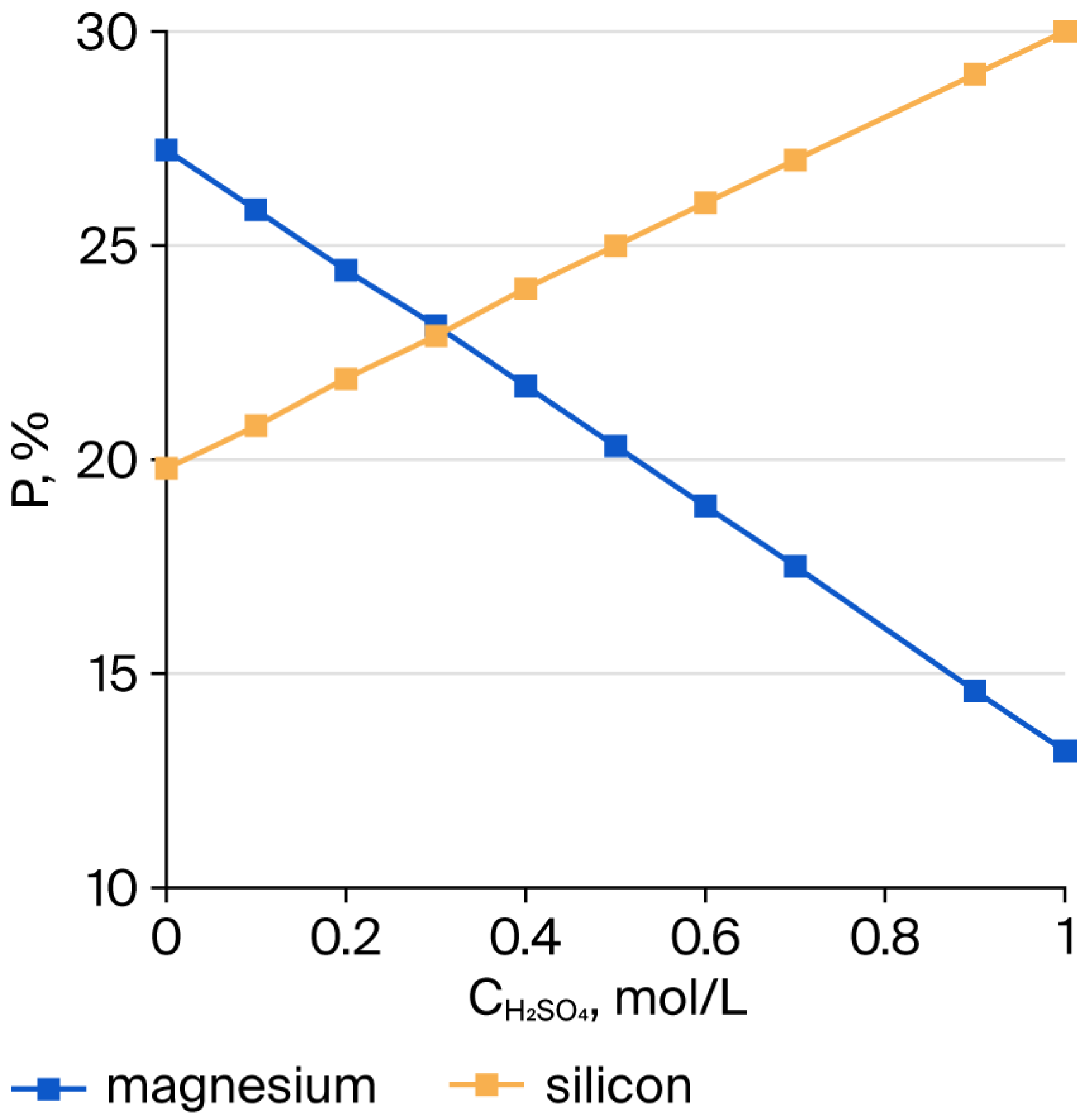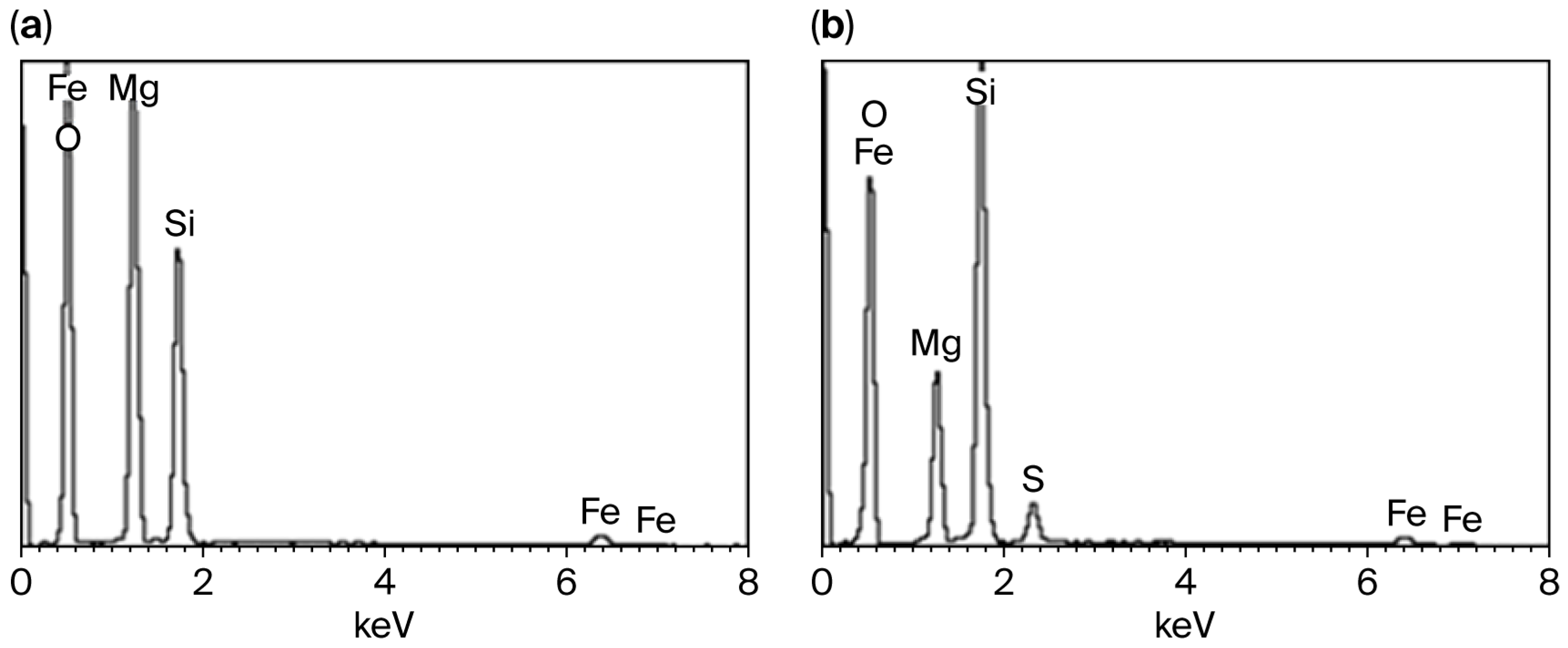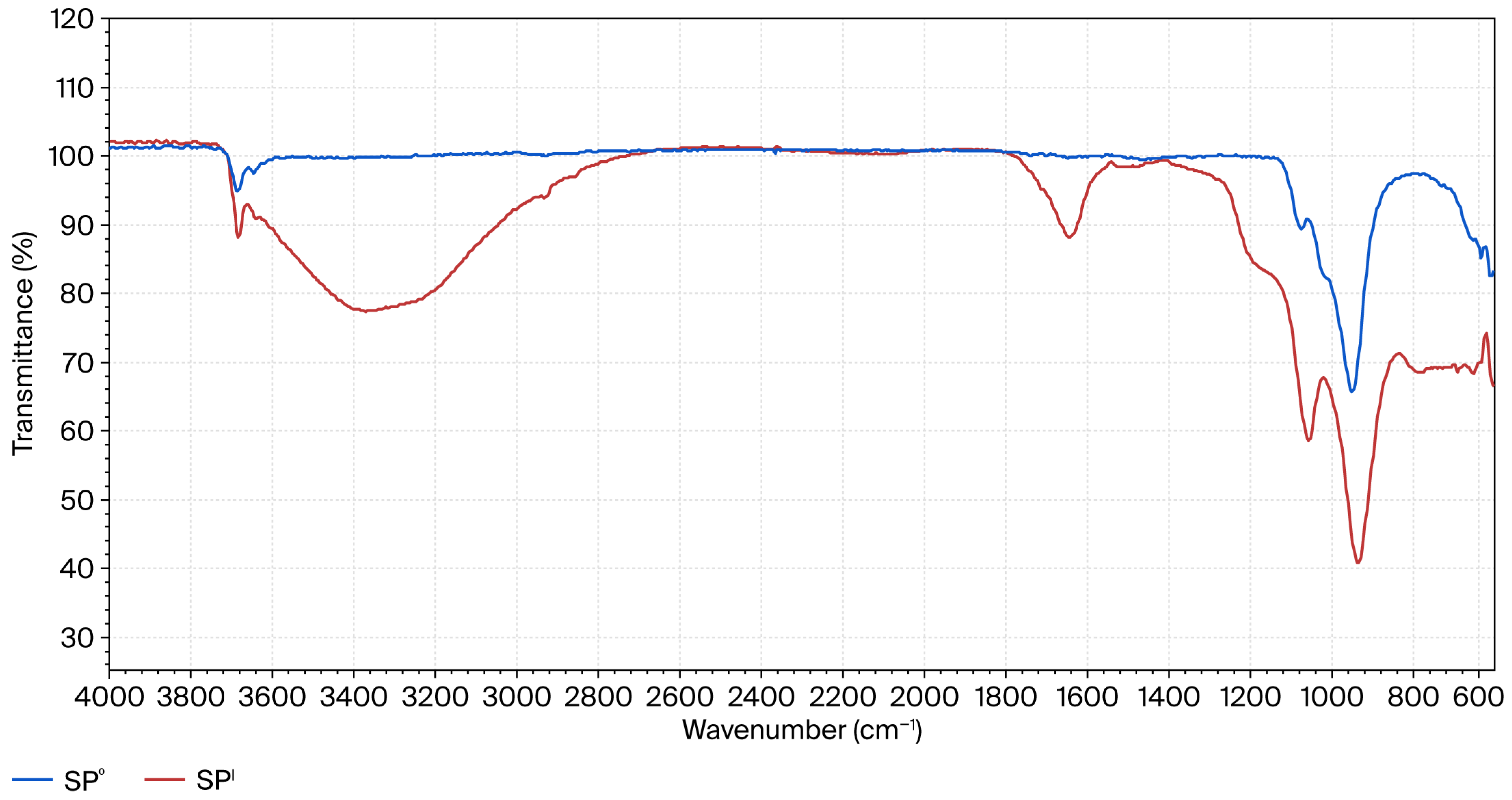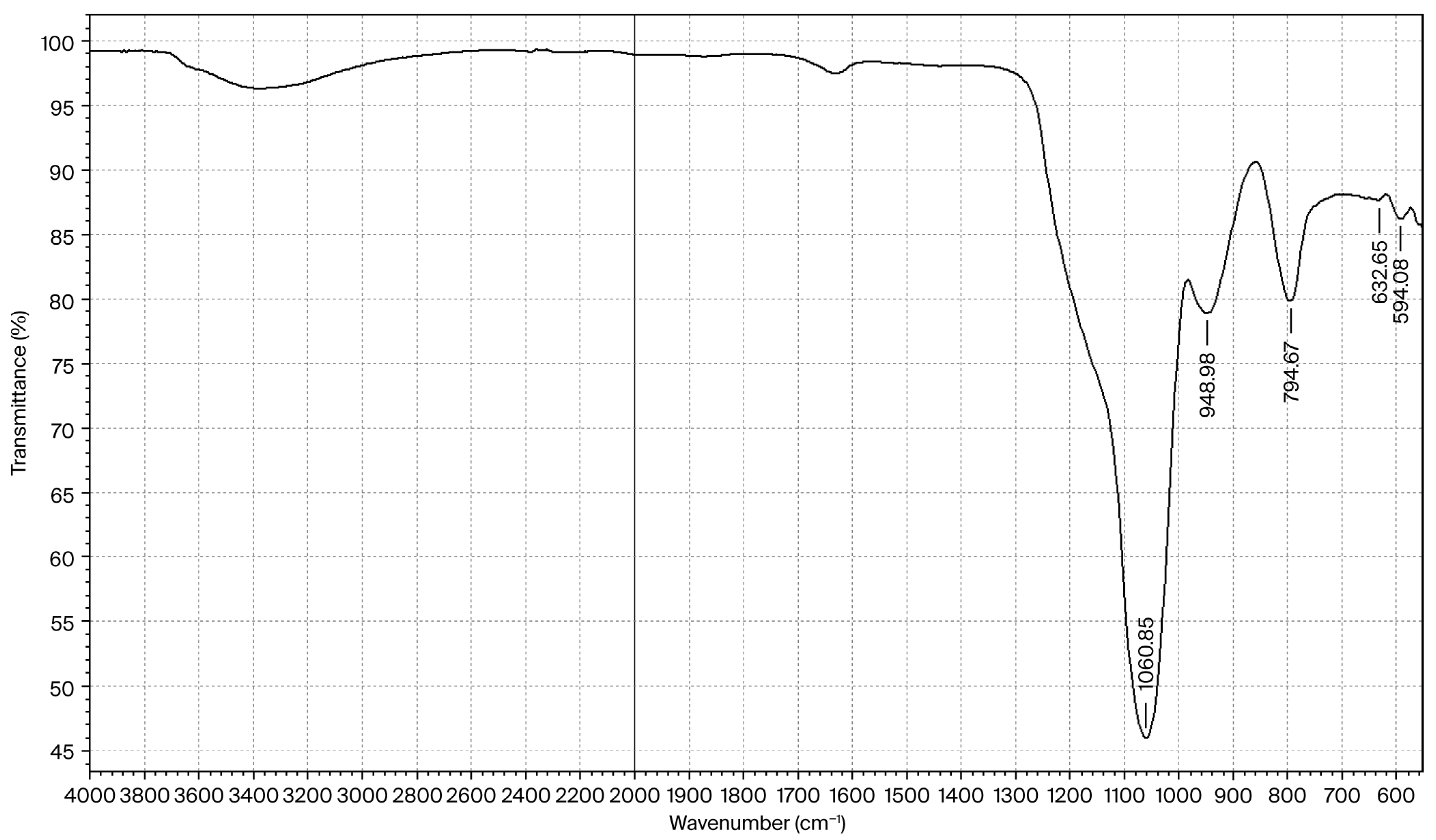Synthesis and Characterization of Silica Obtained by Combined Acid–Alkali Treatment of Serpentinite
Abstract
1. Introduction
2. Results and Discussion
2.1. Interactions in the “Serpentinite–H2SO4” System
2.2. XRD and FTIR Spectroscopy
2.3. Production of Amorphous Silica via the Combined Acid–Alkali Method and Its Properties
2.4. Study of the Properties of Amorphous Silica
3. Materials and Methods
4. Conclusions
Author Contributions
Funding
Data Availability Statement
Conflicts of Interest
References
- Beglaryan, H.; Isahakyan, A.; Zulumyan, N.; Melikyan, S.; Terzyan, A. A study of magnesium dissolution from serpentinites composed of different serpentine group minerals. Miner. Eng. 2023, 201, 108171. [Google Scholar] [CrossRef]
- Liu, W.; Peng, X.; Liu, W.; Zhang, N.; Wang, X. A cost-effective approach to recycle serpentine tailings: Destruction of stable layered structure and solvent displacement crystallization. Int. J. Min. Sci. Technol. 2022, 32, 595–603. [Google Scholar] [CrossRef]
- Vieira, K.R.M.; Arce, G.L.A.F.; Luna, C.M.R.; Facio, V.O.; Carvalho, J.A., Jr.; Soares Neto, T.G.; Ávila, I. Understanding the acid dissolution of Serpentinites (Tailings and waste rock) for use in indirect mineral carbonation. S. Afr. J. Chem. Eng. 2022, 40, 154–164. [Google Scholar] [CrossRef]
- Zhao, D.; Sun, H.; Peng, T.; Zeng, L.; Wu, M. The acid-leaching process and structural changes of lizardite, chlorite and talc in sulfuric acid medium. Clay Miner. 2024, 59, 298–309. [Google Scholar] [CrossRef]
- Chen, Y.; Yang, X.; Wu, L.; Tong, L.; Zhu, J. Recovery of Mg from H2SO4 Leaching Solution of Serpentine to Precipitation of High-Purity Mg(OH)2 and 4MgCO3·Mg(OH)2·4H2O. Minerals 2023, 13, 318. [Google Scholar] [CrossRef]
- Yoo, K.; Kim, B.-S.; Kim, M.-S.; Lee, J.-C.; Jeong, J. Dissolution of Magnesium from Serpentine Mineral in Sulfuric Acid Solution. Mater. Trans. 2009, 50, 1225–1230. [Google Scholar] [CrossRef]
- Auyeshov, A.; Arynov, K.; Yeskibayeva, C.; Dikanbayeva, A.; Auyeshov, D.; Raiymbekov, Y. Transformation of Silicate Ions into Silica under the Influence of Acid on the Structure of Serpentinite. Molecules 2024, 29, 2502. [Google Scholar] [CrossRef] [PubMed]
- Sirota, V.; Selemenev, V.; Kovaleva, M.; Pavlenko, I.; Mamunin, K.; Dokalov, V.; Yapryntsev, M. Preparation of crystalline Mg(OH)2 nanopowder from serpentinite mineral. Int. J. Min. Sci. Technol. 2018, 28, 499–503. [Google Scholar] [CrossRef]
- Fedoročková, A.; Hreus, M.; Raschman, P.; Sučik, G. Dissolution of magnesium from calcined serpentinite in hydrochloric acid. Min. Eng. 2012, 32, 1–4. [Google Scholar] [CrossRef]
- Zulumyan, N.; Mirgorodski, A.; Isaakyan, A.; Beglaryan, H. The mechanism of decomposition of serpentines from peridotites on heating. J. Therm. Anal. Calorim. 2014, 115, 1003–1012. [Google Scholar] [CrossRef]
- Yeskibayeva, C.; Auyeshov, A.; Arynov, K.; Dikanbayeva, A.; Satimbekova, A. Nature of serpentinite interactions with low- concentration sulfuric acid solutions. Green Process. Synth. 2024, 13, 20240034. [Google Scholar] [CrossRef]
- Matus, M.; Korbicz, A.; Pietrzyk, S. Mechanism of Nickel, Magnesium, and Iron Recovery from Olivine-Bearing Ore during Leaching with Hydrochloric Acid Including a Carbonation Pre-Treatment. Metals 2020, 10, 811. [Google Scholar] [CrossRef]
- Ulum, R.; Natalin, R.; Ahmad, M. Pyro-Hydrometallurgy Routes to Recover Silica from Indonesian Ferronickel Slag. Recycling 2023, 8, 13. [Google Scholar] [CrossRef]
- Peng, X.; Liu, W.; Liu, W.; Zhao, P.; Yu, X.; Wang, Y. Fabrication of eco-friendly adsorbent derived from serpentine tailings for removal of organic dyes. Colloids Surf. A Physicochem. Eng. Asp. 2022, 643, 128761. [Google Scholar] [CrossRef]
- Zulumyan, N.O.; Hovhannisyan, E.B.; Hovhannisyan, Z.G.; Karakhanyan, S.S. On thermoacid treatment of serpentinites of the northeastern coast of Lake Sevan. Rep. NAS RA. Inorg. Chem. 2002, 102, 238–242. (In Russian) [Google Scholar]
- Yang, H.; Du, C.; Hu, Y.; Jin, S.; Yang, W.; Tang, A.; Avvakumov, E.G. Preparation of porous material from talc by mechanochemical treatment and subsequent leaching. Appl. Clay Sci. 2006, 31, 290–297. [Google Scholar] [CrossRef]
- Lazaro, A.; Chen, Y.; Verhoeven, C.; Hendrix, Y. One-step synthesis of ordered mesoporous silica from olivine and its pore size tailoring. J. Clean. Prod. 2019, 238, 117951. [Google Scholar] [CrossRef]
- Raza, N.; Raza, W.; Madeddu, S.; Agbe, H.; Kumar, R.V.; Kim, K.-H. Synthesis and characterization of amorphous precipitated silica from alkaline dissolution of olivine. RSC Adv. 2018, 8, 32651–32658. [Google Scholar] [CrossRef] [PubMed]
- Çakan, Y.; Gönen, M. Amorphous Silica Production from Serpentine and Its Techno-Economic Analysis. J. Turk. Chem. Soc. Sect. B Chem. Eng. 2024, 7, 61–68. [Google Scholar] [CrossRef]
- Chukin, G.D. Surface Chemistry and Structure of Dispersed Silica; Paladin Printa LLC: Moscow, Russia, 2008; p. 172. [Google Scholar]
- Thommes, M.; Kaneko, K.; Neimark, A.V.; Olivier, J.P.; Rodriguez-Reinoso, F.; Rouquerol, J.; Sing, K.S.W. Physisorption of gases, with special reference to the evaluation of surface area and pore size distribution (IUPAC Technical Report). Pure Appl. Chem. 2015, 87, 1051–1069. [Google Scholar] [CrossRef]







| Element | Mg | Si | Fe | Mn | Cr | Ca | Al |
|---|---|---|---|---|---|---|---|
| In filtrate (wt.%) | 64.8 | 2.0 | 27.0 | 100.0 | 78.0 | 92.0 | 66.0 |
| In residue (wt.%) | 35.2 | 98.0 | 73.0 | – | 22.0 | 8.0 | 34.0 |
| Total | 100.0 | 100.0 | 100.0 | 100.0 | 100.0 | 100.0 | 100.0 |
| Process | Reaction | Molar Mass, g/mol | Mass, g |
|---|---|---|---|
| Alkaline treatment of SPI | Reaction (1): 1.25MgO·1.5SiO2·3H2O + 3NaOH → 1.5Na2SiO3 + 1.25Mg(OH)2 + 3.25H2O | 194.00 + 120.00 → 183.00 + 72.5 + 58.5 | 83.60 + 51.70 → 78.86 + 31.24 + 25.21 |
| Acid treatment of silicate | Reaction (2): Na2SiO3 + H2SO4 → SiO2↓ + Na2SO4 + H2O | 122.00 + 98.00 → 60.00 + 142.00 + 18.00 | 78.86 + 63.35 → 38.78 + 91.78 + 11.64 |
| Element | Initial SP0 | Stage 1 H2SO4 (SPI) | Stage 2 NaOH (SPII) | Stage 3 H2SO4 (SPIII) | Stage 4 NaOH (SPIV) |
|---|---|---|---|---|---|
| O | 51.68 | 60.04 | 48.71 | 42.50 | 35.71 |
| Mg | 25.60 | 12.61 | 25.01 | 12.81 | 22.95 |
| Al | 0.47 | 0.19 | 0.27 | n.d. | n.d. |
| Si | 17.95 | 21.04 | 18.71 | 31.90 | 18.17 |
| S | n.d. | 4.85 | n.d. | n.d. | n.d. |
| Ca | 0.56 | 0.05 | 0.18 | n.d. | n.d. |
| Cr | 0.20 | 0.04 | 0.17 | 0.04 | 0.32 |
| Mn | 0.11 | n.d. | n.d. | n.d. | n.d. |
| Fe | 3.43 | 3.00 | 6.95 | 12.75 | 22.85 |
| Σ (wt.%) | 100.00 | 100.00 | 100.00 | 100.00 | 100.00 |
| Conditional composition | 3MgO·2SiO2 ·2H2O | 1.25MgO·1.5SiO2 ·3H2O | 1.13MgO·0.72SiO2 ·0.72H2O | 0.53MgO·1.14SiO2 ·H2O | 1.24MgO·0.84SiO2 |
| Sample | S, m2·g−1 | ΣVpore, cm3·g−1 | Vmicro, cm3·g−1 | davg, nm | dmode, nm | Isotherm Type | Hysteresis Loop | |
|---|---|---|---|---|---|---|---|---|
| Amorphous Silica (SiO2) | 400.06 (BET P/P0 = 0.02–0.13) | 0.42 (T-Plot) | 0.09 (T-Plot) | 4.18 (BET) | 5.68 (BJH desorption) | 3.73 (BJH desorption) | IV | H3 |
| 559.13 (Langmuir) | 0.42 (Langmuir) | 0.15 (DR) | 1.57 (DR micro) | 1.82 (DA micro) | 2.14 (DA) | |||
Disclaimer/Publisher’s Note: The statements, opinions and data contained in all publications are solely those of the individual author(s) and contributor(s) and not of MDPI and/or the editor(s). MDPI and/or the editor(s) disclaim responsibility for any injury to people or property resulting from any ideas, methods, instructions or products referred to in the content. |
© 2025 by the authors. Licensee MDPI, Basel, Switzerland. This article is an open access article distributed under the terms and conditions of the Creative Commons Attribution (CC BY) license (https://creativecommons.org/licenses/by/4.0/).
Share and Cite
Auyeshov, A.; Arynov, K.; Yeskibayeva, C.; Ibrayeva, A.; Dzholdasova, E. Synthesis and Characterization of Silica Obtained by Combined Acid–Alkali Treatment of Serpentinite. Molecules 2025, 30, 4076. https://doi.org/10.3390/molecules30204076
Auyeshov A, Arynov K, Yeskibayeva C, Ibrayeva A, Dzholdasova E. Synthesis and Characterization of Silica Obtained by Combined Acid–Alkali Treatment of Serpentinite. Molecules. 2025; 30(20):4076. https://doi.org/10.3390/molecules30204076
Chicago/Turabian StyleAuyeshov, Abdrazakh, Kazhmukhan Arynov, Chaizada Yeskibayeva, Aitkul Ibrayeva, and Elmira Dzholdasova. 2025. "Synthesis and Characterization of Silica Obtained by Combined Acid–Alkali Treatment of Serpentinite" Molecules 30, no. 20: 4076. https://doi.org/10.3390/molecules30204076
APA StyleAuyeshov, A., Arynov, K., Yeskibayeva, C., Ibrayeva, A., & Dzholdasova, E. (2025). Synthesis and Characterization of Silica Obtained by Combined Acid–Alkali Treatment of Serpentinite. Molecules, 30(20), 4076. https://doi.org/10.3390/molecules30204076








